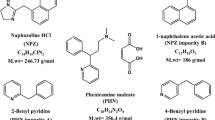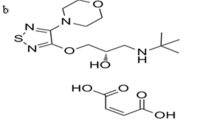Abstract
Green analytical methods have gained a growing interest in the field of pharmaceutical research to reduce impacts on the environment and enhance analysts’ health safety. Chloramphenicol (CHL), dexamethasone sodium phosphate (DSP) and tetrahydrozoline HCl (THZ) form an ophthalmic ternary mixture that is co-formulated for conjunctivitis treatment. In the present work, for time saving and higher sensitivity, two green thin-layer chromatography (TLC) methods were developed for the determination of this ophthalmic ternary mixture in the absence or presence of p-nitroacetophenone (PNA), a synthetic precursor of chloramphenicol. In both proposed methods, silica gel 60 F254 plates were used as the stationary phase. The mobile phase used for method (A) was ethanol‒water‒ammonia (7.0:2.5:0.5, V/V), while, for method (B), acetonitrile‒water‒ammonia (10.0:3.0:0.5, V/V) was used as the mobile phase. TLC separation was followed by quantitative determination of the aforementioned drugs at wavelengths 242.0 nm and 220.0 nm. Both methods were validated in compliance with the International Conference on Harmonisation (ICH) guidelines, where both methods were found to be reliable, reproducible, and selective. Statistical comparison of the developed methods was done with a reported high-performance liquid chromatography (HPLC) method where no significant difference was found. Analytical eco-scaling depends on penalty point which was calculated to be 92, 88 and 87 for methods A, B and the reported HPLC, respectively, suggesting that the proposed methods are eco-friendlier with penalty point scoring very high on the scale than the reported one.




Similar content being viewed by others
References
Welch JC, Wu N, Biba M, Hartman R et al (2010) Greening analytical chromatography. Trends Anal Chem 29:667–680. https://doi.org/10.1016/j.trac.2010.03.008
Lamie NT, Mohamed HM (2015) Application and validation of an eco-friendly TLC–densitometric method for simultaneous determination of co-formulated antihypertensive. RSC Adv 5:59048–59055. https://doi.org/10.1039/C5ra08125d
Abdelaleem EA, Abdelwaha NS (2018) Green chromatographic method for analysis of some anti-cough drugs and their toxic impurities with comparison to conventional methods. Saudi Pharm J 26:1185–1191. https://doi.org/10.1016/J.Jsps.2018.07.007
Attimarad M, Ahmed M, Aldhubaib BE et al (2011) High-performance thin layer chromatography: a powerful analytical technique in pharmaceutical drug discovery. Pharm Methods 2:71–75
Zlatkis A, Kaiser RE (eds) (1977) HPTLC–high-performance thin-layer chromatography. Elsevier Science, Amsterdam
Rathore AS, Lohidasan S, Mahadik KR (2010) Development of validated HPLC and HPTLC methods for simultaneous determination of levocetirizinedihydrochloride and montelukast sodium in bulk drug and pharmaceutical dosage form. Pharm Anal Acta 1:2–6. https://doi.org/10.4172/2153-2435.1000106
Michael AM, Fayez YM, Nessim CK, Lotfy HM (2016) Densitometric methods for the analysis of mebeverine hydrochloride and chlordiazepoxide in their binary mixture. Eur J Chem 7:315–321. https://doi.org/10.5155/eurjchem.7.3.315-321.1468
Janumala H, Kumar P, Baran A (2012) Bacterial keratitis – causes, symptoms and treatment. In: Srinivasan M (ed) Keratit is. IntechOpen, London, pp 16–28. https://doi.org/10.5772/34599
Hamoudi TA, Bashir WA (2018) Spectrophotometric determination of chloramphenicol in pharmaceutical preparations. J Educ Sci 27:19–35
Al-Rimawi F, Kharoaf M (2011) Analysis of chloramphenicol and its related compound 2-amino-1-(4-nitrophenyl)propane-1,3-diol by reversed-phase high-performance liquid chromatography with UV detection. Chromatogr Res Int 2011:1–6. https://doi.org/10.4061/2011/482308
Henderer JD, Rapuano CJ (2006) Ocular pharmacology. In: Brunton LL, Chabner BA (eds) Goodman & Gilman’s – The pharmacological basis of therapeutics, 11th edn. McGraw-Hill, New York, NY, pp 1707–1737
Chen SNQ, Zielinski D, Chen J, Koski A et al (2008) A validated stability-indicating HPLC method for the determination of dexamethasone related substances on dexamethasone-coated drug-eluting stents. J Pharm Biomed Anal 48(3):732–8. https://doi.org/10.1016/j.jpba.2008.07.010
Cuvillo AV, Sastre J, Montoro J et al (2009) Allergic conjunctivitis and H1 antihistamines. J Investig Allergol Clin Immunol 19(1):11–18
Tripathi KD (1999) Essentials of medical pharmacology, 4th edn, p 179. Jaypee Brothers Medical Publishers, New Delhi
Long LM, Troutman HD (1949) Chloramphenicol1 (chloromycetin). VII. Synthesis through p-Nitroacetophenone. J Am Chem Soc 71:2473–2475. https://doi.org/10.1021/ja01175a068
Collins RJ, Ellis B, Hansen SB, et al (1952) Some observations on the structural requirements for antibiotic activity in the chloramphenicol series, Part II. J Pharm Pharmacol 4:693–710. https://doi.org/10.1111/j.2042-7158.1952.tb13204.x
Lotfy HM, Saleh SS, Hassan YN, Salem H (2014) A Comparative study of novel spectrophotometric methods based on isosbestic points; application on a pharmaceutical ternary mixture. Spectrochim Acta 126:112–121. https://doi.org/10.1016/J.Saa.2014.01.130
Saleh SS, Lotfy HM, HassanYN SH (2014) A comparative study of progressive versus successive spectrophotometric resolution techniques applied for pharmaceutical ternary mixtures. Spectrochim Acta 132:239–248. https://doi.org/10.1016/J.Saa.2014.05.004
Salem H, Hassan NY, Lotfy HM, Saleh SS (2015) Column performance study of different variants of liquid chromatographic technique: an application on pharmaceutical ternary mixtures containing tetryzoline. J Chromatogr Sci 53:708–715. https://doi.org/10.1093/Chromsci/Bmu109
Alaani H, Alnukkary Y (2016) Stability-indicating HPLC method for simultaneous determination of chloramphenicol, dexamethasone sodium phosphate and tetrahydrozoline hydrochloride in ophthalmic solution. Adv Pharm Bull 6:137–141. https://doi.org/10.15171/Apb.2016.020
Alaani H, Alnukkary Y, Alashkar I (2014) Stability and kinetic studies for the estimation of shelf life of chloramphenicol, dexamethasone sodium phosphate, and tetrahydrozoline hydrochloride ophthalmic solution. Int J Pharm Sci Rev Res 57:327–330
Hassan NY, Lotfy HM, Saleh SS, Salem H (2015) Development of membrane electrodes for the specific determination of tetryzoline hydrochloride in presence of its degradation product in pharmaceutical formulations and biological fluids. Anal Bioanal Electrochem 7(1):75–90
Gałuszka A, Migaszewski ZM, Konieczka P, Namiesnik J (2012) Analytical eco-scale for assessing the greenness of analytical procedures. Trends Anal Chem 37:61–72. https://doi.org/10.1016/J.Trac.2012.03.013
British Pharmacopoeia Commission (2012) British Pharmacopoeia, vol 2. Stationery Office, London
Pyka A, Babuska M, Bober K, Gurak D, Klimczok W, Miszczyk M (2006) Influence of temperature of silica gel activation on separation of selected biologically active steroid compounds. J Liq Chromatogr Relat Technol 29:2035–2044. https://doi.org/10.1080/10826070600758449
Chaban VV, Maciel C, Fileti EE (2014) Does the like dissolves like rule hold for fullerene and ionic liquids? J Sol Chem 43:1019–1031. https://doi.org/10.1007/s10953-014-0155-6
International Conference on Harmonisation (2003) ICH Q1A(R2) Harmonised tripartite guideline, stability testing of new drug substances and products. Geneva
Al-Alamein AMA, El-Rahman MKA, Abdel-Moety EM, Fawaz EM (2019) Green HPTLC–densitometric approach for simultaneous determination and impurity – profiling of ebastine and phenylephrine hydrochloride. Microchem J 147:1097–1102. https://doi.org/10.1016/j.microc.2019.04.043
Tobiszewski M (2015) Green chemistry metrics with special reference to green analytical chemistry. Molecules 20:10928–10946. https://doi.org/10.3390/molecules200610928
Mohamed HM, Lami NT (2016) Analytical eco-scale for assessing the greenness of a developed RP-HPLC method used for simultaneous analysis of combined antihypertensive medications. J AOAC Int 99:1260–1265. https://doi.org/10.5740/Jaoacint.16-0124
Dias LD, Gonçalves KHE, Queiroz JE, Vila GM et al (2018) An eco-friendly and alternative method of forced degradation of fluoroquinolone drugs by microwave irradiation : a new application for analytical eco-scale. J Microw Power Electromagn Energy 52:162–181. https://doi.org/10.1080/08327823.2018.1494470
Tobiszewski M (2016) Analytical methods metrics for green analytical chemistry. Anal Methods 8:2993–2999. https://doi.org/10.1039/C6ay00478d
Acknowledgements
The authors would like to express their gratitude to Egyptian International Pharmaceutical Industries Co and Orchidia Company, Cairo, Egypt, for donating pure chloramphenicol, dexamethasone sodium phosphate and tetrahydrozoline HCl samples.
Funding
This research did not receive any specific grant from funding agencies in the public, commercial, or not-for-profit sector.
Author information
Authors and Affiliations
Corresponding author
Ethics declarations
Conflict of interest
There are no conflicts of interest to declare.
Rights and permissions
About this article
Cite this article
Eissa, M.S., Abd El-Hadi, H.R., Zaazaa, H.E. et al. Smart TLC–densitometric methods for determination of ophthalmic ternary mixture containing chloramphenicol in the presence of its synthetic precursor: Comparative eco-scaling for greenness assessment. JPC-J Planar Chromat 33, 501–509 (2020). https://doi.org/10.1007/s00764-020-00055-8
Received:
Accepted:
Published:
Issue Date:
DOI: https://doi.org/10.1007/s00764-020-00055-8




